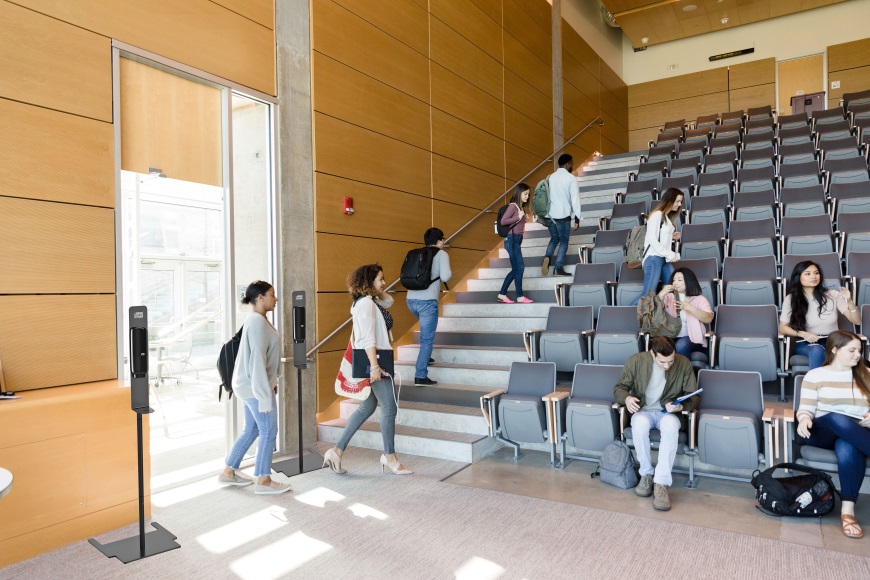Environmental issues including climate change, air pollution, poor ocean health and the loss of biodiversity are stirring great change across the world. Governments, businesses and citizens all have an important part to play in protecting the planet for generations to come.
Young people are highly engaged with issues concerning sustainability. A study has shown that 94%1 of students believe that universities could do more to be environmentally sustainable. This means that implementing sustainable initiatives across campus is more important than ever. By shifting to even more sustainable models, universities can act as ‘change agents’, helping to lead society forward.
As the science points to an increasingly clear consensus and a more urgent case for action, we examine what universities can do to make study more sustainable. From using the right cleaning products, to saving water and being transparent about carbon footprints, you’ll find lots of ideas below.
Be transparent about carbon footprinting
In practical terms, colleges and universities have a vital role to play when it comes to acting for the planet. As people-centric establishments, higher education institutions can act as change leaders for how organizations can impact the climate. Universities also have a responsibility to educate future leaders on the importance of sustainability.
In the global scientific community, there is a broad discussion about the necessity of universities to become carbon neutral. Currently, a minority of universities record and publish comprehensive carbon inventories. Those published in local languages may not be easily available for international comparison.
This is one area where the United States is succeeding. University carbon footprinting is most institutionalized in the USA2, where over 1,000 Higher Education Institutions3 have registered to use the STARS Reporting Tool. STARS is a transparent, self-reporting tracking system for colleges and universities to measure their sustainability performance.
Foster a ‘culture of sustainability’

There are over 5,000 colleges and universities in the United States, and many of them have been implementing more sustainable practices into their operations for some time.
As well as being transparent about carbon footprinting, students themselves are calling for strong action on climate change across campus – including bans on single use plastics and a reduction in waste that goes to landfill.Students also want to see environmental issues integrated into their subjects as part of the core curriculum4, and into student life via extracurricular activities that emphasize environmental issues.
The real challenge is understanding how to create a culture of sustainability across campus. This involves trying to ‘sustain’ sustainability in their organizations in the long term. A university with a strong sustainability culture is one that seeks to support the environment long into the future while continuing to operate successfully today.
Learn from universities that are making a big sustainability impact
Creating a culture of sustainably in a university building means investing in the future. According to the Times Higher Education Impact Rankings for 2022, Arizona State University is one of the top in terms of sustainability. ASU is committed to leading the world by example by creating a circular resource system. The university promotes a zero-waste policy across campus and strives to minimize water usage.
Another good case study is Washington University. The Missouri school has invested a significant sum of money into its campus infrastructure with an aim of ‘designing for the future while celebrating the school’s historic past’. Washington University now holds the most5 platinum level LEED certifications among U.S universities.
Invest in the right cleaning products to support a healthy building

In addition to utilizing healthful building materials and furniture, Washington University also follows the same guidelines for personal and household cleaning products, led by the Six Classes Approach to reducing chemical harm.
When schools don’t have the budget to transform their infrastructure, taking small steps to better sustainability is key. Students value the campus experience and the university’s commitment to the environment. Showing commitment to sustainability through the choice of cleaning products and services can be key to success.
Tork helps higher education institutes to deliver positive experiences through award-winning, sustainable hygiene solutions. High-capacity dispensers, third-party certified compostable paper hand towels, Green Seal certified hand sanitizer and hand soap made from natural ingredients, and Tork Vision Cleaning – the world’s leading facility management solution for data-driven cleaning – can help support your university campus sustainability strategy.
Learn how your university can take action with the Tork Campus Hygiene Package.
Sources
1 Tork: Student experience on campus
2 Environmental Sciences Europe: Carbon footprinting of universities worldwide
3 Environmental Sciences Europe: Carbon footprinting of universities worldwide
4 Emerald Insight: How students are taught about sustainability
5 USGBC: Washington University leads in LEED
